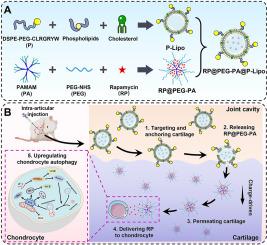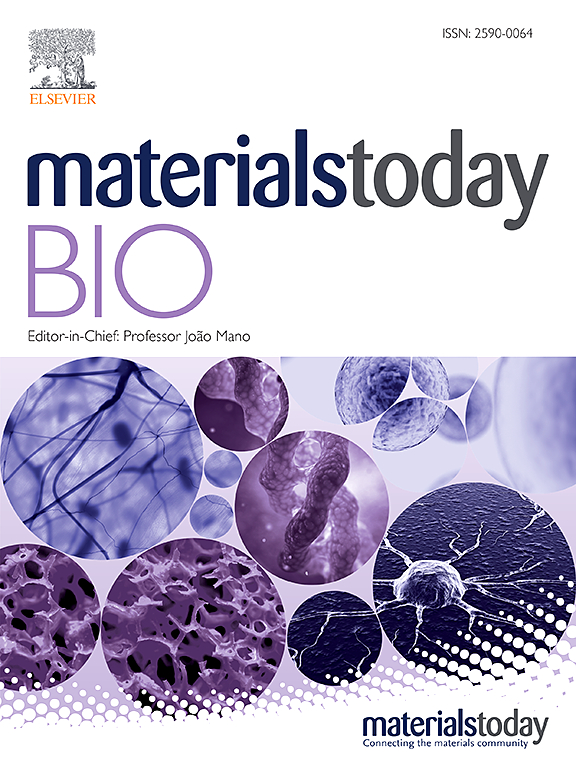Enhancing retention and permeation of rapamycin for osteoarthritis therapy using a two-stage drug delivery system
IF 8.7
1区 医学
Q1 ENGINEERING, BIOMEDICAL
引用次数: 0
Abstract
Osteoarthritis (OA) remains a challenging degenerative joint disease, largely associated with chondrocyte apoptosis during its development. Preserving chondrocytes stands as a promising strategy for OA treatment. Rapamycin (RP) exhibits chondrocyte protection by fostering autophagy. Nevertheless, the swift clearance of intra-articular injections and the dense cartilage extracellular matrix (ECM) hinder RP from effectively reaching chondrocytes. Herein, we developed a "two-stage" drug delivery system (RP@PEG-PA@P-Lipo). This system comprises primary nanoparticles (P-Lipo), liposomes modified with a collagen II targeting peptide (WYRGRLC), and secondary nanoparticles (RP@PEG-PA), PEG-modified PAMAM encapsulating rapamycin (RP). RP@PEG-PA@P-Lipo demonstrates adherence to the cartilage surface with WYRGRLC, substantially prolonging retention within the joint cavity. Subsequently, released RP@PEG-PA can effectively penetrate the cartilage and deliver RP to chondrocytes through small size and charge-driven forces. In vitro and in vivo experiments corroborate its notable therapeutic effects on OA. This study holds promise in offering a novel approach for clinical drug delivery and OA treatment.

利用两级给药系统提高雷帕霉素在骨关节炎治疗中的保留率和渗透率
骨关节炎(OA)仍然是一种具有挑战性的退行性关节疾病,在很大程度上与其发展过程中的软骨细胞凋亡有关。保护软骨细胞是治疗骨关节炎的一种有效策略。雷帕霉素(RP)可通过促进自噬作用保护软骨细胞。然而,关节内注射的快速清除和致密的软骨细胞外基质(ECM)阻碍了雷帕霉素有效到达软骨细胞。在此,我们开发了一种 "两阶段 "给药系统(RP@PEG-PA@P-Lipo)。该系统由一级纳米颗粒(P-Lipo)和二级纳米颗粒(RP@PEG-PA)组成,前者是用胶原蛋白 II 靶向肽(WYRGRLC)修饰的脂质体,后者是包裹雷帕霉素(RP)的 PEG 修饰 PAMAM。RP@PEG-PA@P-Lipo 与 WYRGRLC 一起附着在软骨表面,大大延长了在关节腔内的保留时间。随后,释放的 RP@PEG-PA 可有效穿透软骨,通过小尺寸和电荷驱动力将 RP 输送到软骨细胞。体外和体内实验证实了它对 OA 的显著治疗效果。这项研究有望为临床给药和治疗 OA 提供一种新方法。
本文章由计算机程序翻译,如有差异,请以英文原文为准。
求助全文
约1分钟内获得全文
求助全文
来源期刊

Materials Today Bio
Multiple-
CiteScore
8.30
自引率
4.90%
发文量
303
审稿时长
30 days
期刊介绍:
Materials Today Bio is a multidisciplinary journal that specializes in the intersection between biology and materials science, chemistry, physics, engineering, and medicine. It covers various aspects such as the design and assembly of new structures, their interaction with biological systems, functionalization, bioimaging, therapies, and diagnostics in healthcare. The journal aims to showcase the most significant advancements and discoveries in this field. As part of the Materials Today family, Materials Today Bio provides rigorous peer review, quick decision-making, and high visibility for authors. It is indexed in Scopus, PubMed Central, Emerging Sources, Citation Index (ESCI), and Directory of Open Access Journals (DOAJ).
 求助内容:
求助内容: 应助结果提醒方式:
应助结果提醒方式:


